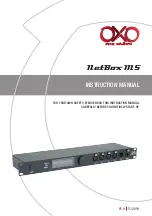
ID-AL - My Music Player and My Music Player LE - User Guide V1.0
For more information about FTP update, please refer to Management of the Main Storage Device Content
(page 38) and FTP Client Page
(page 84).
. Creating a Scheduler File
The Scheduler file is generated by the Scheduler software developed for this purpose. Please check our
website for additional information (www.id-al.com support page). The files generated by the Scheduler
software are TM3 files with the
.tm3
extension. Prior to any use of the Scheduler software, carefully read the
information related to its prerequisites as well as its user’s guide.
Important:
The Scheduler file must be named
scheduler.tm3
. Another naming is not supported.
. Application of a Timestamped Programming to the Player
Once the Scheduler programming file has been created, copy this programming file
scheduler.tm3
into
the
SYSTEM
folder of the Main Media storage device.
The Scheduler programming file is copied in the same way as the other files, for more information regarding
the updating of the content, please refer to Main Storage Device (Main Media) (page 15) and Management of
the Main Storage Device Content (page 38).
9.4. Management of the Main Storage Device Content
. Introduction
All the files and folders of the Main Media (audio contents, playlists, Scheduler, etc.) can be added, deleted,
renamed, or moved using various methods. The most suitable method depends on the context of use.
The following table describes the available methods and their characteristics, defined below:
•
Network:
required network access to the player:
◦
None: no network.
◦
Local: through a local network (LAN).
◦
Remote: through the Internet.
•
Handling:
whether a local handling of the player is required.
•
Scheduler:
whether the content update can be programmed with the Scheduler.
•
Deployment:
expected scale of the number of players to update.
•
Provider Skills:
skill level of the provider required to prepare and deploy a content update.
-38-
© 2017, Waves System
















































